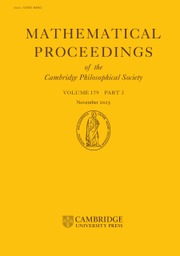No CrossRef data available.
Article contents
Functional degrees and arithmetic applications III: beyond prime exponent
Part of:
Arithmetic algebraic geometry
Abelian groups
Finite commutative rings
Representation theory of groups
Published online by Cambridge University Press: 30 May 2025
Abstract
Continuing our work on group-theoretic generalisations of the prime Ax–Katz Theorem, we give a lower bound on the p-adic divisibility of the cardinality of the set of simultaneous zeros  $Z(f_1,f_2,\dots,f_r)$ of r maps
$Z(f_1,f_2,\dots,f_r)$ of r maps  $f_j\,{:}\,A\rightarrow B_j$ between arbitrary finite commutative groups A and
$f_j\,{:}\,A\rightarrow B_j$ between arbitrary finite commutative groups A and  $B_j$ in terms of the invariant factors of
$B_j$ in terms of the invariant factors of  $A, B_1,B_2, \cdots,B_r$ and the functional degrees of the maps
$A, B_1,B_2, \cdots,B_r$ and the functional degrees of the maps  $f_1,f_2, \dots,f_r$.
$f_1,f_2, \dots,f_r$.
MSC classification
Primary:
13M10: Polynomials
Information
- Type
- Research Article
- Information
- Mathematical Proceedings of the Cambridge Philosophical Society , Volume 179 , Issue 2 , September 2025 , pp. 409 - 438
- Copyright
- © The Author(s), 2025. Published by Cambridge University Press on behalf of Cambridge Philosophical Society
References
Aichinger, E. and Moosbauer, J.. Chevalley–Warning type results on abelian groups. J. Algebra 569 (2021), 30–66.10.1016/j.jalgebra.2020.10.033CrossRefGoogle Scholar
Ax, J.. Zeroes of polynomials over finite fields. Amer. J. Math. 86 (1964), 255–261.10.2307/2373163CrossRefGoogle Scholar
Chevalley, C.. Démonstration d’une hypothèse de M. Artin. Abh. Math. Sem. Univ. Hamburg 11 (1935), 73–75.CrossRefGoogle Scholar
Clark, P.L. and Schauz, U.. Functional degrees and arithmetic applications I: the set of functional degrees. J. Algebra 608 (2022), 691–718.CrossRefGoogle Scholar
Clark, P.L. and Schauz, U.. Functional degrees and arithmetic applications II: the group-theoretic prime Ax–Katz theorem. Preprint: Arxiv: 2305.01304 (2023).Google Scholar
Clark, P.L. and Triantafillou, N.. Ax’s lemma and Ax’s theorem in the Aichinger-Moosbaer calculus. J. Algebra 659 (2024), 542–580.10.1016/j.jalgebra.2024.06.025CrossRefGoogle Scholar
Grynkiewicz, D.. A generalisation of the Chevalley–Warning and Ax–Katz theorems with a view towards combinatorial number theory. Combinatorica 43 (2023), 1179–1213.10.1007/s00493-023-00057-0CrossRefGoogle Scholar
Katz, N.M.. On a theorem of Ax. Amer. J. Math. 93 (1971), 485–499.10.2307/2373389CrossRefGoogle Scholar
Katz, D.J.. Point count divisibility for algebraic sets over
 $\mathbb{Z}/p^{\ell}\mathbb{Z}$
and other finite principal rings. Proc. Amer. Math. Soc. 137 (2009), 4065–4075.Google Scholar
$\mathbb{Z}/p^{\ell}\mathbb{Z}$
and other finite principal rings. Proc. Amer. Math. Soc. 137 (2009), 4065–4075.Google Scholar
Katz, D.J.. On theorems of Delsarte-McEliece and Chevalley–Warning-Ax–Katz. Des. Codes Cryptogr. 65 (2012), 291–324.10.1007/s10623-012-9645-yCrossRefGoogle Scholar
Karasev, R.N. and Petrov, F.V.. Partitions of nonzero elements of a finite field into pairs. Israel J. Math. 192 (2012), 143–156.CrossRefGoogle Scholar
Kummer, E.. Über die Ergänzungssätze zu den allgemeinen Reciprocitätsgesetzen. J. Reine Angew. Math. 44 (1852), 93–146.Google Scholar
Moreno, O. and Moreno, C.J.. Improvements of the Chevalley–Warning and the Ax–Katz theorems. Amer. J. Math. 117 (1995), 241–244.CrossRefGoogle Scholar
Marshall, M. and Ramage, G.. Zeros of polynomials over finite principal ideal rings. Proc. Amer. Math. Soc. 49 (1975), 35–38.Google Scholar
Schauz, U.. Classification of polynomial mappings between commutative groups. J. Number Theory 139 (2014), 1–28.CrossRefGoogle Scholar
Schauz, U.. The largest possible finite degree of functions between commutative groups. Preprint: Arxiv: 2103.16467 (2023).Google Scholar
Warning, E.. Bemerkung zur vorstehenden Arbeit von Herrn Chevalley. Abh. Math. Sem. Hamburg 11 (1935), 76–83.Google Scholar
Weisman, C.S.. Some congruences for binomial coefficients. Michigan Math. J. 24 (1977), 141–151.10.1307/mmj/1029001876CrossRefGoogle Scholar
Wilson, R.M.. A lemma on polynomials modulo
 $p^m$
and applications to coding theory. Discrete Math. 306 (2006), 3154–3165.CrossRefGoogle Scholar
$p^m$
and applications to coding theory. Discrete Math. 306 (2006), 3154–3165.CrossRefGoogle Scholar

